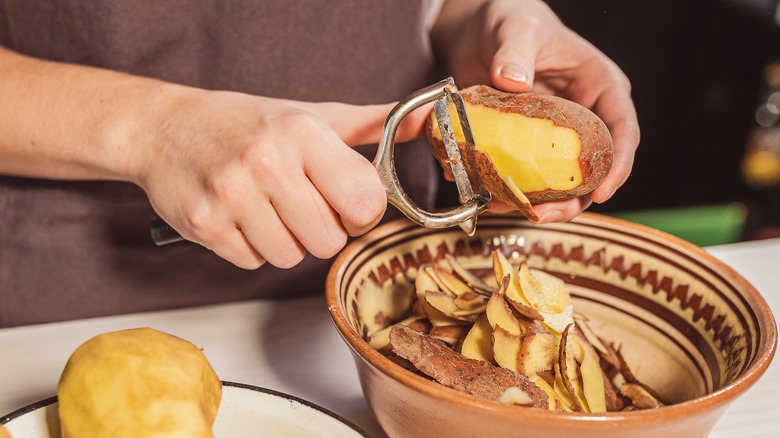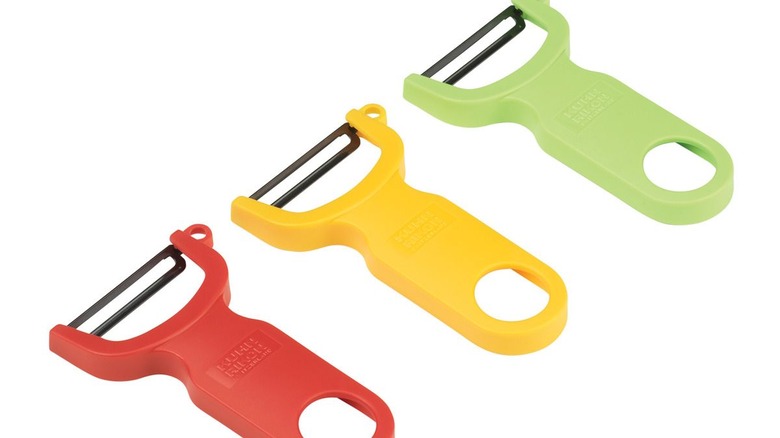Why You Shouldn't Spend A Lot Of Money On A Vegetable Peeler
We may receive a commission on purchases made from links.
Most cooks, Ina Garten included, agree that vegetable peelers are a kitchen tool staple. In fact, the Barefoot Contessa has one listed on her necessary kitchen Equipment List.
WHy are they necessary? Well, unless you're a knife skill ninja, they're a superior peeling tool to a paring knife. It takes some serious ability to peel an apple without paring away too much flesh along with that skin. However, even a kitchen novice can handle the same task with a vegetable peeler. They're easy to learn, quick to use, and belong next to your cutting board.
But, in the camp of peeler lovers, there's division. There are exceptions, but peelers have two blades to handle designs. According to America's Test Kitchen, with "straight" peelers, you'll find the blade extending out from the handle but a "Y" peeler "look like wishbones, with a blade running perpendicular to the handle." That difference ignites some serious hatred aimed at straight peelers. Yahoo!Life editors debated the difference and found a pretty even split between straight vs y-shaped peeler aficionados. In the end, the shape of your peeler is up to you. But, they're an important part of your kitchen tool kit.
You can upgrade your peels
Once you've decided on the shape of peeler you prefer, there's no shortage of things this humble tool can do. Good Housekeeping lays out ten ways to fully utilize a peeler. These include peeling things you might not have considered, like a mango, celery, or chalk. Yes, chalk. Most peelers have a notch for removing eyes on a potato but that can also be used to hull strawberries. Peel off large swaths of citrus zest for an old fashioned. Ditto for parmesan cheese to garnish a Caesar salad. How about some chocolate curls to sprinkle onto the tiramisu?
Serrated peelers are an interesting potential peeler upgrade. These use blades that are serrated, like a bread knife. Those toothed blades, "make quick work of separating tough, thin skin from delicate fruit such as ripe peaches and tomatoes" per America's Test Kitchen. Aside from possibly saving you from blanching and shocking those fruits, these can replace a standard bladed peeler for every peeling task. As long as you don't mind the mini-ridged surface these leave behind.
Inexpensive doesn't mean cheap
Like any kitchen tool, there's almost no limit to what you can spend. In the case of a vegetable peeler, there's no reason to spend much at all. Even if it's your first kitchen, pro chefs and home cooks alike swear by the Kuhn Rikon Original Swiss Peeler. Food & Wine declares it as "a long standing favorite in our kitchens." A set of three of these can be found for under $15. The carbon steel blades are sharp, but they can be prone to rust. Preventing that is simple, per Food & Wine, "wash and dry your peeler immediately after use, and make sure it's completely dry before stashing it in the drawer."
Even if that tiny price makes these seem disposable, you can sharpen a peeler. Old's Cool Kevmo demonstrates a way to use a hone, or steel, to realign the blades of your peeler. It makes sense, a peeler is just a few knife blades mounted for a specific task. This technique will keep your peeler sharper for much longer. What's better than an inexpensive peeler? An inexpensive peeler that lasts a long time!


